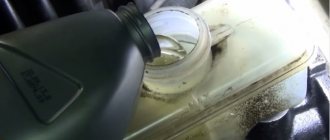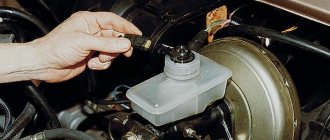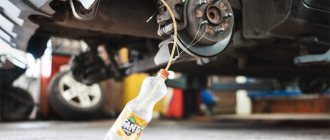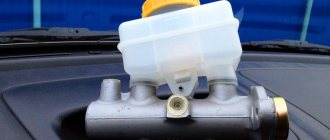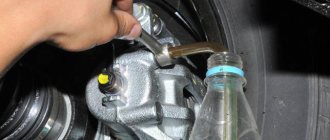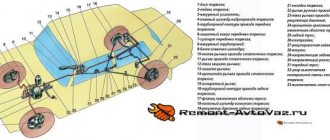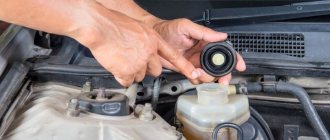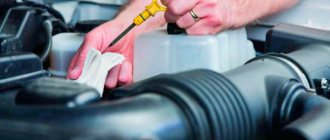Many VAZ 2107 car owners are interested in the question: how much oil should be poured into the main components of the car, such as the engine, gearbox or rear axle? In fact, this information is included in every vehicle operating manual that is issued upon purchase at a car dealership. But if you are the owner of a used vehicle or for some other reason do not know what the main filling capacities of important units are, then this information will be provided in more detail below.
VAZ 2107: model review
"Seven" is one of the iconic models in the Lada line. Initially, the modification of the VAZ 2107 was based on the traditions of the VAZ 2105, but AvtoVAZ designers largely modified and improved the model.
VAZ 2107 is one of the latest “classic” models, which was produced from March 1982 to April 2012. It is curious that according to the results of the 2022 study, 1.75 million people owned the “Seven” in Russia.
All basic vehicle data is indicated both in documents and in a summary table. It is made of aluminum and is mounted on the bottom shelf of the air supply box. The plate displays information about the model and body number, type of power unit, weight data, spare part numbers, etc. Directly next to the plate there is an embossed VIN code.
Curious facts about the "seven"
The VAZ 2107 car was extremely popular not only in the USSR and Russia. Thus, the “seven” became a cult car in Hungary, where it was often used not only for personal needs, but also in racing competitions.
And even in modern times, the VAZ 2107 never ceases to amaze car enthusiasts with its capabilities. Thus, in the Russian Classic Rally Championship in 2006–2010, the “seven” was among the winners. The model confirmed its confident position in 2010–2011 at the Russian Championship in automobile circuit racing.
And in 2012, the VAZ 2107 was equipped with a remote control at competitions in Astrakhan and also showed excellent results.
Technical characteristics of VAZ 2107
The model is a classic rear-wheel drive sedan. There are no front-wheel drive modifications for the VAZ 2107.
The car was only slightly different in size from its predecessor, the “six”:
The curb weight of the “seven” was 1020 kg, the total weight was 1420 kg. As on all VAZ models, the fuel tank volume was 39 liters. For the vast majority of owners, the trunk volume of 325 liters provided the necessary space for transportation.
Initially, carburetor modifications of power units were installed on VAZ 2107 cars. Depending on the year of manufacture, the engine could operate with either a four-speed gearbox or a five-speed gearbox.
An important feature of the engines on the “seven” is that until 1995 they were equipped with a breaker relay, which can be easily detected when braking with the handbrake.
The braking system was inherited from the “seven” from the “six”: front disc brakes and rear drum brakes.
The ground clearance of all VAZ modifications was not designed for off-road driving, but 175 mm of ground clearance makes it possible to cope perfectly with uneven road surfaces.
In total, over the entire period of production of the VAZ 2107, the car was equipped with five types of engines:
The power unit is located in the front of the machine in the longitudinal direction.
Video: main characteristics of the machine
All about model refueling fluids
As mentioned above, the VAZ 2107, like all models of the manufacturer, is equipped with a 39-liter gas tank. This volume is quite enough for long continuous trips. Of course, in recent years, due to a sharp increase in fuel prices, the tank volume has become enough for only 3-4 hours of driving on the highway.
Fuel
Initially, the “seven” was refueled exclusively with A-92 gasoline. However, some of the latest versions of the model implied the use of diesel fuel (VAZ 2107 - diesel). However, diesel modifications of the VAZ 2107 did not gain popularity in Russia due to the high cost of the car and increased fuel consumption.
Engine oil
Another filling fluid for the car is the oil in the power unit. AvtoVAZ engineers recommend that drivers fill the engine with lubricant that meets the minimum requirements of API SG/CD standards . This marking is usually indicated on containers with consumable liquid.
Review of Manufacturer Prices
| Name/catalogue number of brake fluid | Price in rubles |
| DOT4 250ml TRW PFB425 | From 145 |
| DOT5.1 250ml TRW PFB525 | From 180 |
| DOT4 500ml TRW PFB450 | From 220 |
| DOT5.1 500ml TRW PFB550 | From 220 |
| DOT5.1 ESP 500ml TRW PFB750 | From 220 |
| DOT4 1L TRW PFB401 | From 220 |
| DOT5.1 1L TRW PFB501 | From 220 |
| DOT4 ESP 1L TRW PFB440 | From 220 |
| DOT4 ESP 1L TRW PFB440 | From 220 |
| DOT4 5L TRW PFB405 | From 220 |
| *prices are as of May 2022 | |
Description of the salon
Having first appeared in 1982, the VAZ 2107 did not differ from its predecessors and competitors in any modern devices or design. However, even those little things that the manufacturer decided to introduce into the new Lada model played into the hands: the car became more convenient and attractive for drivers.
Interior trim
The interior trim was fully consistent with Soviet ideas about fashion. For example, higher quality plastic and wear-resistant fabrics were used. For the first time, the seats acquired an anatomical shape and received comfortable headrests. In general, the VAZ 2107 was the first in the manufacturer’s line to receive the title of a comfortable car for people.
Dashboard
However, if the interior, at the very least, stood out from similar AvtoVAZ models, the instrument panel was always made in strict accordance with existing standards. We can say that the dashboard is featureless, although it houses the tachometer and additional services of instruments and sensors.
This is probably why almost all VAZ 2107 owners try to somehow personalize the instrument panel in their cars. Some hang icons, others - flavors, others - toys... After all, a dull instrument panel affects the mood, so depending on capabilities and taste, drivers often resort to tuning this area of the car.
Gear shift diagram
The gearbox on the VAZ 2107 is needed to transmit torque from the engine to the transmission.
The gear shift pattern on a five-speed gearbox is not much different from a four-speed one: the only difference is that another speed has been added, which is activated by pressing the lever all the way to the left and forward.
All 7 gearboxes also have reverse gear. The transmission itself is necessarily sewn into the housing with a lever located on it to change gears.
Video: how to change gears in a car
Thus, the VAZ 2107 model successfully continued the traditions of the domestic automotive industry. The modification is considered one of the most popular in Russia, as it combines build quality, the presence of only the instruments and mechanisms necessary for driving, and an affordable price.
Source
Types of DDM
Oil pressure sensors are divided into two types:
- Mechanical. They are used on cars that have become legends in the automotive industry, in particular, VAZ 2101, UAZ, Moskvich 401/407/412/, 2141 and others.
- Electronic. Installed on all modern cars, for example, domestic VAZ 2114, Kalina and other Lada models, as well as foreign cars.
Mechanical sensors
Mechanical sensors by design are divided into:
- Devices with two rods and a capillary tube.
- Devices with a rheostat.
The first ones consist of a body, a membrane, two rods, and a sealed tube.
As the pressure in the lubrication system increases, the membrane bends, putting pressure on the first rod, thereby increasing the pressure in the tube. The second rod takes this pressure and transmits it to the differential pressure gauge (located on the instrument panel).
The pressure increases - the arrow of the device deviates in a larger direction, falls - the arrow goes down to the left. The principle of operation is the same as that of a pressure gauge.
The mechanical oil pressure sensor with rheostat consists of:
- Cases.
- Membranes.
- Slider.
- Nichrome winding (resistor).
The device operates on the principle of a voltmeter. The rheostat and slider play a key role here.
The rheostat changes its resistance depending on where the slider is moved. The latter, in turn, shifts in one direction or another as the membrane bends or straightens.
When there is no pressure, the membrane is not deformed and the slider does not move, the current passes freely without encountering any resistance along its path.
As the pressure increases and the membrane deforms, the slider moves along the rheostat, thereby increasing the resistance in the circuit; accordingly, the current readings change, which is displayed on the device in the driver’s cabin.
All this is recorded by the ECU, to which the sensor is connected. It is programmed in such a way that only one period of current values is equal to the standard oil pressure. Exceeding this interval is equivalent to an incorrect value.
This is clearly visible on dial analog pressure gauges, which, in fact, are ordinary voltmeters.
Electronic sensors
Electronic DDM is much simpler than its mechanical counterpart, so it is considered more reliable.
Essentially, this is an emergency sensor that does not show the pressure in the system, but only notifies the driver when it is within normal limits and when it is not.
Principle of operation. When pressure is not applied to the sensor membrane, it is not deformed. The rod is in a position in which the circuit contacts are closed and current flows through them. At this moment, a lamp is lit in the cabin, which is monitored by the driver.
When the engine starts, the oil pressure in the system increases, the membrane bends, the rod moves, opening the circuit. The light goes out.
If after starting the engine the lamp does not go out within 1-2 seconds, you must immediately turn off the engine and do not start it until the cause of the malfunction is determined.
Read more here - what to do if the oil pressure lamp is on https://autotopik.ru/remont/1062-gorit-lampa-davleniya-masla.html.
Based on the above, we can conclude that the basis for checking the oil pressure sensor on modern cars is measuring the resistor resistance with a multimeter and checking the DDM for opening and closing the circuit.
To do this, the multimeter is switched to resistance or continuity measurement mode. It depends on what type of sensor is being tested with or without a resistor.
But there are other verification methods, which we will discuss below.
How much antifreeze in VAZ 21043
Home » Tech. service » Replacing antifreeze
Reading time: 7 minutes. .6k.
A classic of the Soviet automobile industry, the VAZ 2104 (four), has earned the love of car enthusiasts as a cheap car to maintain. Most often, owners try to carry out repairs and maintenance themselves. Replacing antifreeze is one of these maintenance operations, which you can also do yourself if you follow the instructions.
Antifreeze volume in the car
The first thing you need to know is how much antifreeze can be poured into a VAZ 2107 so that it works stably. For cars of brands such as VAZ 2101, 2105, 2106 and VAZ 2107, the volume of fluid is the same - 9.85 liters, it must be replaced every two years. Replacing antifreeze on a VAZ 2107 occurs in the following way:
The volume of coolant in a VAZ 2107 can reach up to ten liters. Antifreeze is suitable for the engine cooling system, as it prevents heat from entering the engine and cools the radiator. The cooled antifreeze is moved to the car engine using a pump. This process continues until engine operation stops. During operation, antifreeze heats up and loses its positive properties, so it must be changed periodically. The process of heating the antifreeze occurs when the car travels a distance of about 60 thousand kilometers.
Cleaning and preventing plaque in the system
The injector device is very sensitive to large inclusions in gasoline. If you are using a cheap brand of fuel, be prepared to change your injectors soon. So the first thing you should do for your VAZ fuel pump is change the brand of fuel. The power supply system of the VAZ 2107 should become cleaner; the possibility of plaque formation in the system is still not excluded. Since the flammable liquid in the channels occasionally stagnates and sometimes even freezes, an early breakdown can be prevented only in one way - regular cleaning.
Approximately every 35-40 thousand km it is necessary to carry out preventive cleaning work on the fuel system. You need to wash the channels with your own hands. The performance of the engine will depend on the quality of cleaning. If this procedure is carried out irregularly, then soon you can say goodbye to one injector and look for a new one, and then you will have to change the remaining elements of the VAZ fuel pump.
In 4-cylinder types of injection engines, different intensities of injector clogging are observed. The temperature in the area of cylinders 2 and 3 is always elevated, so sediment accumulation occurs there faster.
A special admixture of polyetheramine is considered a prophylactic agent in such cases. It prevents the accumulation of burning for a long time.
Methods for replacing antifreeze
Many beginners do not know how to drain antifreeze from a VAZ 2107. Since it is a toxic substance, it must be treated with extreme caution, and it is better to adhere to general safety rules. Immediately before draining the liquid from the car, you need to prepare some kind of container or simply use an unnecessary basin . The following steps are followed:
In order to correctly fill the liquid and it does not leak out, you need to check the integrity of the pipe. If the pipe is damaged even slightly, it should be replaced. Replacing the coolant in the injection VAZ 2107 is carried out as follows:
It is very important to remember that replacement occurs when the radiator has cooled down. A VAZ 2107 or 7 may have injectors or a carburetor. The carburetor operates using a simplified cooling system.
The operation of the injector depends on the system of installed devices and temperature sensors. All screwing of the lids can be done with a simple thirteen key. Why do you need antifreeze:
Antifreeze has many advantages, the main one is the continuous operation of the engine. If the cooling system operates without interruption, the liquid will not boil and the engine will continue to operate for a long time. Antifreeze is safe for the car; it does not contain substances contraindicated for cooling systems.
Stages of replacing lubricant VAZ 2105
On classic Lada cars or the more familiar Zhiguli, a convenient drainage of used oil from the engine is provided. The oil filter is also easily accessible and can be reached from the engine compartment.
During the production of the VAZ 2105, a large number of modifications were produced, which were equipped with various engines. Experienced drivers note good maintainability, unpretentiousness in maintenance, as well as consumables.
Before starting to replace the lubricant, precautions should be taken. Please note that the drained waste will be at a high temperature.
Since the replacement is carried out on a warm engine.
Draining waste fluid
Before starting the draining procedure, you should prepare tools, empty containers, as well as new liquids for subsequent filling. If additional protection is installed under the engine, it can also be removed for convenience.
Next, we perform the procedure for draining the liquid from the VAZ 2105:
- We lift the hood, under it we find the filler neck on the engine and unscrew the plug (Fig. 1).
To unscrew the filter element, it is advisable to have a special puller. If it is not available, you can try to unscrew the filter using improvised means. In this case, you can use, for example, an old alternator belt, a regular belt, a bicycle chain or a simple screwdriver.
Using this method, you can drain the maximum amount of used oil, after which you can proceed to further actions. The main thing is not to forget, everything that we unscrewed must be put back in place.
Flushing the lubrication system
Flushing the engine on a VAZ 2105 should be carried out only in exceptional cases, which include:
- Purchasing a used car when you cannot know about the quality, as well as the regularity of lubricant replacements.
During operation, the service replacement interval was repeatedly exceeded.
Engine operation with constant frequent overheating, which contributes to coking and other deposits. In cases of switching to another type, for example from synthetics to semi-synthetics.
There are several types of flushes for the VAZ 2105 engine:
- Five- or seven-minute, capable of cleaning even the most difficult deposits. They must be used very carefully and strictly follow the instructions printed on the packaging. It is recommended to use them only when absolutely necessary. Since there is a high probability of causing premature wear of the sealing seals. And also clog the oil channels with particles of washed away carbon deposits.
- Special compounds that are added to the oil several hundred kilometers before the expected change. They are more gentle, but there is also a possibility of clogging of the oil channels.
- Flushing oil is the most gentle method of cleaning the engine from the inside. This composition is poured after draining the waste, the engine runs for 15-20 minutes, after which the liquid with deposits is drained. The absence of aggressive additives in the wash composition gently cleans the engine, but is not able to remove heavy contaminants.
- Regular oil that you are going to use when changing. This method is not so popular due to its high price.
Installing a filter, filling in new engine fluid
If the VAZ 2105 lubrication system is sealed and does not require repair work to eliminate leaks, you can proceed to filling in fresh engine oil. In addition to the oil itself, we may need a new drain plug, its part number 14325301. As well as the original oil filter 2101-1012005.
When everything is ready, let's move on to the bay:
- Replace the drain plug and replace it with a new one if necessary.
- We tighten and put the oil filter in place. Pre-lubricate the rubber sealing ring with fresh oil.
- Pour new oil into the filler neck.
- We check the level on the dipstick; it should be between the MIN and MAX marks.
- We start the engine, let it run for 10-15 seconds, then turn it off.
- After 5 minutes, check the level with a dipstick and top up if necessary.
Lack of fluid and consequences
The disadvantage of antifreeze is rapid evaporation; you also have to solve the problem of leakage.
It happens that liquid can be seen leaking under the car. There are also cases when it goes into the car interior, this indicates a breakdown of the heater taps, they need to be replaced. In addition, smoke may be emitted from the exhaust pipe. This occurs due to a faulty cylinder head gasket. When antifreeze boils, you need to fix the problem in time ; you need to drain it and change it.
If you do not give significance to the signs that appear and continue to move on, then the consequences can be very sad. If the fluid disappears from the tank, the motor may overheat when the mark reaches the minimum value.
Soft and stiff brake pedal
The normal position of the brake pedal of the 2107 model is when there are no jerks or dips when pressed, and no effort is required. At the same time, during the operation of the car, car owners are sometimes faced with the fact that the brake pedal manifests itself in a completely different way, that is, it becomes too tight or soft. Such manifestations are unacceptable and indicate problems in the braking system. Therefore, prompt repairs are required. Often the pedal becomes soft when the system is too airy. This phenomenon is also called failure. The damage can be repaired by bleeding the brakes, that is, it is necessary to remove accumulated air from the system. The latter could have happened due to the following reasons:
- not enough fuel fluid in the expansion tank;
- sealing in the braking system is broken;
- damage to the brake cylinder.
At the same time, there is a situation where when pressing the pedal it requires excessive force, for which the vacuum booster (VA) is to blame. This mechanism creates a vacuum in the manifold (intake). The fact that the pedal is tight is indicated by a number of reasons:
- the VU air filter is clogged, therefore, it needs to be replaced;
- the VU valve body is jammed; the vacuum booster should be replaced;
- the VU diaphragm is damaged; replacement of the control unit is required;
- wear of the tip of the device; the tip needs to be replaced;
- incorrect operation of the check valve in the control unit; it is worth replacing;
- the seal is broken; the VU or check valve should be replaced;
- damage to the hose connecting the intake manifold and the intake manifold, or the tightening of the clamp in it is loose;
- increasing the size of cuff cylinders in brake cylinders; this happens when using poor quality fuel fluid.
How to replace coolant on a VAZ 2101-VAZ 2107?
Draining: 1) First, drive the car into the pit.
Note! The car must be level, or the front must be higher than the rear, but not vice versa!
2) Then remove the crankcase protection (For information on how to remove the crankcase protection, read the article “Replacing the crankcase protection”)
3) Next, move all the way to the right, the lever that opens the supply of warm air into the car interior; in the VAZ 2106, such a lever is located on top and in the photo it is indicated by the letter “A”.
4) Next, unscrew and then remove the expansion tank plug, which is indicated by an arrow in the bottom photo.
5) Then unscrew the radiator filler cap, which is also indicated by an arrow in the photo below.
6) Now remove the drain plug located on the cylinder block.
Note! After you unscrew the drain plug located on the cylinder block, immediately place a bottle under this hole and drain all the used fluid into it!
7) Then unscrew the radiator drain plug and drain all the waste fluid from the radiator into a bottle.
 Next, unfasten the belt that secures the expansion tank, and then lift the tank up, as a result of which the remaining coolant will drain out of it and from the hose that is connected to it, which will flow through the radiator drain hole.
Next, unfasten the belt that secures the expansion tank, and then lift the tank up, as a result of which the remaining coolant will drain out of it and from the hose that is connected to it, which will flow through the radiator drain hole.
Filling: 1) First, install the radiator tank in place, and also tighten the cylinder block drain plug and the radiator drain plug.
2) Then pour new coolant into the radiator.
3) Next, pour new fluid into the radiator expansion tank.
Note! Pour new coolant into the expansion tank, just 3-4 cm above the MIN mark!
4) Next, remove any air pockets in the engine cooling system. (For information on how to do this, read the article “Removing air locks in the cooling system”)
5) Now screw the radiator cap and expansion tank cap into place.
6) Then start the car and let it idle for about 4-5 minutes, after 4-5 minutes of operation, turn off the car and add coolant to the expansion tank and radiator to the required level.
Important!
Additional video: Don’t understand where the expansion tank is located? And you also don’t understand where the drain plug is located on the cylinder block? Watch the video below for answers to all these questions:
Where is the sensor located
The most common places where it is found are near the oil filter, in the upper part of the engine near the camshaft block, or pump.
Let's look at specific models:
- VAZ 2108/09/099. Located on the top right side of the engine (when viewed in the direction of travel) next to the timing belt cover. There is only one wire coming from it. This arrangement is also typical for 8-valve engines on the VAZ 2110/11.
- VAZ 2110/11 16 valve engine. Located on the left side of the engine (when viewed in the direction of travel) on the driver's side on the camshaft block between the air filter, ignition module and oil filler neck.
- VAZ 2112, 16-valve engine. It is located on the top left side (look along the way). To find it you need to remove the air filter.
- VAZ 2114. Located on the right inner side of the engine on the cylinder head next to the timing belt. It is clearly visible from above. To dismantle it, remove the protective cap, the terminal and turn it out with a 21 key.
- Lada Kalina. Located on the right rear of the engine near the timing belt, one wire comes from it. To get to it you need to remove the plastic cover of the cylinder block.
- Lada Priora. Located on the left (when viewed along the way) on top of the cylinder block under the intake air manifold. To dismantle it, you must first remove the protective plastic cover of the engine, move the air manifold and unscrew it with a 21 mm socket wrench. It sits very tight.
- Lada Granta 8 and 16 valve engine. Located on the top right side of the engine near the timing belt cover. To remove it, you can use a spark plug wrench or a 21 open-end wrench.
- GAZ "Gazelle" (engine ZMZ-405). Located on the BC, top right. There is only one wire coming from it.
The most common wrench size for removing the sensor is 21. You can use a spark plug wrench. But it all depends on the specific brand of car.
After the pressure sensor has been removed, the seat is tightly covered with a clean rag so that dirt does not get there and oil does not leak out during possible engine operation.
It would be a good idea to measure the oil pressure in the system at idle, medium and high speeds. To do this, use a pressure gauge, which is screwed in instead of the DDM
To take accurate readings, it is important to ensure a tight connection
For each car model, the values may differ. These can be found in the instruction manual.
For example, for a VAZ 2112 there are 16 valves, the standard engine oil pressure is:
- at idle speed 2 BAR.
- at 5 thousand revolutions from 4.5 to 6.5 BAR.
If all the readings are normal and the light is constantly on, then the information does not reach the ECU or gets distorted. This may be due to the sensor, which needs to be checked.
Replacement frequency, what antifreeze to fill
According to the manufacturer's recommendation, it is necessary to replace antifreeze or antifreeze on VAZ 2104 cars every 2 years or after a mileage of 60 thousand kilometers. If the car is used in more severe conditions, then it is advisable to replace it more often - every 30-40 thousand kilometers.
In all cases, it is necessary not only to replace, but also to check the entire engine cooling system for serviceability.
As a coolant for the VAZ 2104, you can use good Lukoil antifreeze. Or a lesser-known but high-quality product from Gazprom Neft. When replacing, you can also fill in antifreeze, preferably with G12 approval, it is safer for the entire system. You can also use original Lada G12 antifreeze, which is suitable for all cars of this manufacturer.
Source
Refill tanks for VAZ 21074 injector
After purchasing a car, many novice car owners ask a number of questions regarding fuels, lubricants and operating fluids.
Even “experienced” drivers are not always confident in the correct maintenance of their car, and therefore turn to various books and other sources for the necessary information. Some people ask car dealers for advice, and they, in turn, use special manuals and applications for a particular make and model of car to answer their questions.
The table below contains basic information on the lubricants, operating fluids and fuel (gasoline) used, and also provides data on the locations and volumes of refueling for VAZ 2101, 2102, 2103, 2104, 2105, 2106, 2107 or simply “ classic ” cars.
Here you can find answers to the following questions:
This is a reminder for drivers of the VAZ 2107 (also relevant for other classics), I decided to create it because minor technical questions often arise, and it takes a lot of time to find the answer. And here everything is in one place. Save this reminder in your bookmarks or on your page on a social network, and use the social network buttons under the article for your health.
So, VAZ 2107 technical characteristics, dimensions, parameters.
VAZ 2107 was produced from March 1982 to April 2012. It has been produced in Egypt since 2006 to this day. It has a 5-seater sedan-type body, in-line 4-cylinder gasoline engines, paired with a 4 or 5-speed manual transmission. It is included in the class of subcompact cars, according to the European classification - class “B”. And not C, as they say on the forums. C class is Ford Focus, KIA Ceed, etc. Wheel formula 4x2, rear wheel drive. The ancestor is the Italian Fiat 124.
Operating standards for technical fluids
Already at the development stage, the manufacturer determines the parameters of the machine, which are refined during the testing process. So, in the described car, model VAZ 2107, the volume of the fuel tank corresponds to the size of the niche in the trunk behind the right wheel arch. Crankcases of other mechanisms contain the following quantities of operating fluids:
Operating standards for the VAZ 2107 car were developed by the manufacturer for organizations and enterprises. Knowing the volume of fuel that the tank or crankcases of other mechanisms hold, it is easy to calculate the amount required for travel.
Possibilities for upgrading the machine
In the nineties of the last century, many owners of VAZ 2107 cars, not particularly counting on gas stations, installed an additional tank in the car. This is much more convenient than pouring fuel from cans. Typically, such a container was located behind the rear seat in the trunk. It could have different sizes, and accordingly they had the appropriate capacity.
The driver in those days often encountered empty gas stations, and the additional volume of the fuel tank greatly expanded the capabilities of the car. Knowing the required amount of technical fluids is necessary for routine maintenance of the engine and other systems.
